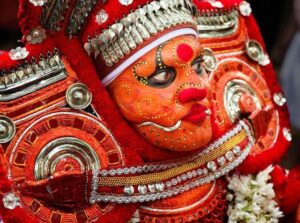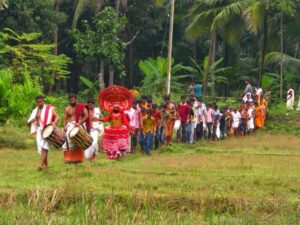
Sacred groves are patches of wilderness conserved owing to their perceived importance attached to a village deity. These are miniature evergreen forest within areas of human settlements nurtured by tradition and sustained by beliefs. These groves are inseparably linked with rituals and festivals that safeguard the cultural moorings of the ethnic community.
Conservation of biodiversity is the idea conveyed by kavu. More than being a collection of trees, kavus represents ecosystems that throb with lives of thousands of beings. Some survive today as patches of forest area reminding us of our heritage of eco-conservation.
There are nearly 1000 kavus in Kannur and Kasaragod district. The micro climate and soil profile that is seen in Tavidisseri kavu, Kammadam kavu, Teyyottu kavu and like which are less than 100 feet above sea level and at a distance less than 10 kilometers from the sea, have not survived in any other part of Kerala. It is very likely that the life forms hitherto unknown to modern science can be discovered in such kavus. The plant Lepidagathis keralensis was first collected from Madai kavu near Payyannur (Madhusoodanan and Singh, 1992). But it was being used as medicine by local healers, especially the folk pediatricians from Vannan community who named the plant as Paramullu. The plant that was used as ‘Vrischikkali’for centuries by the healers of Payyannur was locally known as ‘Thekkida’. It was only in 1982 that this plant was identified and named as Heliotropium keralensis

Among the plants that grow in the Kavus of North Kerala, at least 50 are endemic to Western Ghats and folk practitioners utilize most of them as raw drug sources. At least 500 plants growing in Kannur district are recognized medicinal plants in the Ayurveda and folk systems. The medicinal plants that are made available through the kavus nourish and sustain a fascinating tradition of folk medicine.
Sacred groves provided refuge to some plant communities that have disappeared from forest tracts. Poongoottu kavu at Mattannur (Kannur) and Paliyeri kavu have representative patches of Myristica swamp, – a forest type that has only a few remnants in our forests. More than 50 percent of the plant species in Myristica swamps are endemic to western ghats. Myristica and Syzigium are typical tree specieses in swamp groves. Paliyerikavu of Karivellur (Kannur) is the only abode of Myristica fatua var.magnifica ,an endemic and endangered tree. The tree Syzigium travancoricum was believed to be extinct due to over exploitation for timber after it was rediscovered in 1981. Presently this rare tree species is found surviving in the fresh water swamps of Andallur kavu in Thalasseri, Konginichal kavu and paliyeri kavu near Payyannur(Kannur) and Cheerma kavu in Cheruvathur(Kasaragod).

The sacred grove of Thekkumpad is the only remaining patch of natural vegetation representing a transition from littoral to mangrove vegetation in whole of the west coast. Chamakkavu of vellur is typical vegetation dominated by Syzigium zeylanicum and Memycylon umbellatum. Rare medicinal plants such as Eezhal (Embelia tjeramcottam), Kutaluchurukki (Morinda umbellataum) Ilippa (Madhuca longifolia) Vellappain (Vateria indica) etc. are present in this unique ecosystem. The rare orchid Valiya Orilathamara (Nervelia araguana) is found only in poomalakkavu of Kanayi. Two other species of Nervelia, N.prianiana and N.infundibulifolia are used in place of Orilathamara and they grow abundant in Idayilakkattu kavu near Trikaripur.
Temple ponds and other holy bathing ghats are also homes to Reptiles and fishes. The practice of offering rice and food to tortoise or fish is for being cured of diseases is still prevalent in many sacred groves. Hypselobagrus brachysoma is a fish locally called Manjaletta that is threatened with extinction in Kerala has been carefully protected in muthukattu kavu by traditional beliefs. Terrapins and land tortoises are considered sacred and are conserved in some temple ponds. Natural lake in the surroundings of Molothumkavu, Kasaragod has a large number of them. It is believed that offering of rice meal to these animals will cure wart. The fresh water crocodile – Mugger – was common in the temple ponds of Kerala till about a century back. However now in Kerala, this endangered reptile remains only in the pond of Ananthapuri temple, Kumbala in Kasaragod district.
There are many kavus in Kerala linked with deities like Kali, Serpent gods, sasta and so on. Large kavus exhibiting great diversity of life are concentrated in the Northern region of Kerala especially in Kannur- Kasaragod districts. Perhaps it is the variety of the deities worshipped during the Theyyam festival or Kaliyattam, a tradition unique to North Kerala that has led to the creation of a greater number of Kavus here. Theyyam rituals comprise ancestoral worship, Demonolatry, Zoolatry, Dendrolatry, Virginal cult and blood cult.
The rituals and rites in sacred groves show a performed influence of saiva ,vaishnava and saktheya cult and Budhist roots. Hindu and Muslim folk of Arikkady village, Kasaragod worship Ali, a Muslim black magic man turned as theyyam known as Alichamundi. The communal harmony of Northern Kerala is indebted to this mode of tolerance and blending of culture. Each community has sacred groves and a team of people – a community body attached to it, who controlled the community life, administer the kavu too. This community body helped the functioning of peasant’s organizations and later this tradition strengthened their will to defy feudal lords and fight against them. (Kurup 1973) The revolutionary organizations drew their life blood from such traditional platform, which buttressed their unity and awakened class-consciousness.
It seems that many of the kavus in Kerala have classical temples built on them, which has led to the disappearance of much forestland. Only the kavus of north Kerala have offered some resistance to this trend. Predictably, these have a dense vegetation and greater biodiversity compared to those found in South Kerala.
The kavus remind us of the importance of preserving forest even as human activities make their clearance inevitable. That is why they can be considered, in spite of being close to human habitation, as centers of excellence in situ conservation. Most of our forests and rivers have come under the sway of multinational monopolies. While we expound on the importance of eco conservation, it would be a great tragedy if we let the kavus also become pray to developmental programs that go counter to the environment. We cannot ignore the reasons that lure a common man to fell kavu for kavu is felled not because of the ignorance of its environmental importance or because of its timber value but forced by the reclamation of land, occupied by the kavu which is significant for a small holder who owns only a few cents of land. So it’s only natural that one seeks the available ritual options that help one to get rid of the kavu from ones own holding. So, new institutional alternatives will have to be explored for providing additional incentives, for the individuals maintaining kavus and conserving and biological diversity. One possible alternative could be an exemption of land or building tax for those willing to maintain small refugia for vanishing biological entities in the scared grove in their homestead. This will not only provide a material incentive but also a cultural and social incentive for biodiversity conservation.


